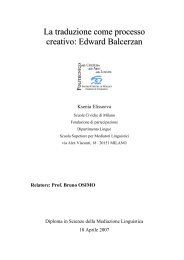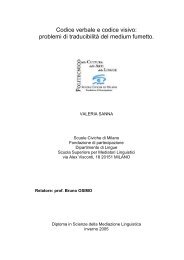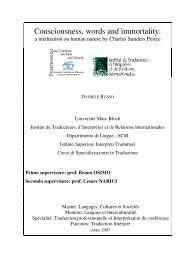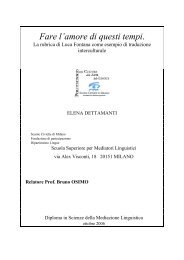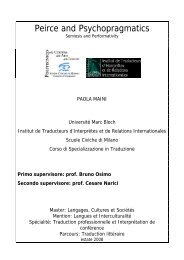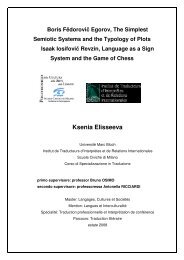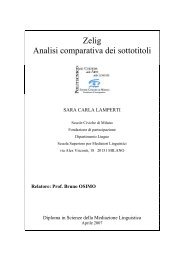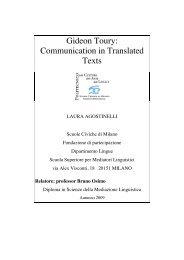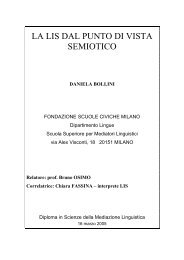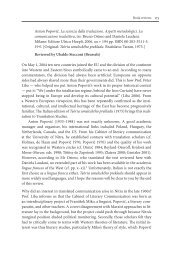A Semiotic Approach to the Theory of Translation: - Bruno Osimo ...
A Semiotic Approach to the Theory of Translation: - Bruno Osimo ...
A Semiotic Approach to the Theory of Translation: - Bruno Osimo ...
Create successful ePaper yourself
Turn your PDF publications into a flip-book with our unique Google optimized e-Paper software.
It is <strong>the</strong> acquisition <strong>of</strong> I TN S that is <strong>the</strong> most difficult problem<br />
for human translation (T H ) and machine translation (T M ). How<br />
does T H acquire it By (1) linguistic analysis <strong>of</strong> context, close or<br />
wide-ranging, surface or deep; or (2) extralinguistic analysis. In<br />
my example <strong>the</strong> sentence that constitutes <strong>the</strong> entire surface<br />
context <strong>of</strong> masse does nothing <strong>to</strong> resolve its ambiguity, nor<br />
would any deeper analysis help. Ei<strong>the</strong>r we need a larger context<br />
(Dans la rue il y avait beaucoup de gens…), or else some<br />
extralinguistic information. If we do not envisage T M <strong>of</strong> literary<br />
texts at present, it is not so much because <strong>of</strong> linguistic difficulties<br />
as because <strong>of</strong> <strong>the</strong> amount <strong>of</strong> extralinguistic information needed.<br />
The Reference System. We have seen that linguistic<br />
understanding can be described as choice between significations.<br />
But <strong>to</strong> make <strong>the</strong> choice we must be aware that it is <strong>the</strong>re, e.g., be<br />
able <strong>to</strong> recognize masse as having two or more significations and<br />
<strong>to</strong> identify each <strong>of</strong> <strong>the</strong>m. Logic and linguistics <strong>of</strong>fer two<br />
approaches <strong>to</strong> <strong>the</strong> identification <strong>of</strong> significations, viz., <strong>the</strong><br />
referential and <strong>the</strong> logical:<br />
Referential identification: by <strong>the</strong> thing itself, e.g., by showing<br />
<strong>the</strong> object.<br />
Logical identification: explanation <strong>of</strong> a sign by ano<strong>the</strong>r sign<br />
or by a combination <strong>of</strong> sings. For this we may use signs <strong>of</strong><br />
ano<strong>the</strong>r language, but also signs <strong>of</strong> <strong>the</strong> same language.<br />
37



